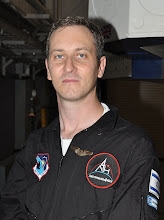 |
| Prof. Ehud Behar (left) and me after his talk, 26 July 2012 |
This was Prof. Behar's last appearance in a two-week tour of the US. He is an eloquent speaker posessing the landmark Israeli accent that I share as well. Fluent in English, he kept his audience of about seventy engaged, weaving trade humor into his talk.
For example, Israel launches its satellites west, contrary to any other of the few launching nations. Why is that? As Prof. Behar stated, some say it is for the same reason we write from right to left instead of like most others... Joking aside, the special geo-political environment Israel is in effectively dictates launching west, which is akin to swimming up-stream in a river or running against the wind. Instead of getting a 'push' from Earth rotation, the rocket has to fight against it in order to reach the velocity around Earth necessary to maintain orbit rather than fall back down.
In his talk Prof. Behar talked about SAMSON, a project to be launched in 2015, where a cluster of satellites will follow a designated leader and work in cooperation, a setup useful for creation of a distributed space telescope, for example. He also discussed a space telescope project which will be launched in a folded state in order to fit the Israeli Shavit launcher and then unfold in orbit (the NASA James Webb Space Telescope (JWST) will also use this technique to spread its solar wings and mirror when it gets to L2, the always-in-the-dark Lagrange point).
During the Q&A session that followed, Prof. Behar answered questions varying from space mining, where he is a proponent of robotics and believes it is more likely such missions will be carried by robots than by humans, to the public use of space, where data accumulated from instruments like Hubble is publicly available to anyone for conducting their own analysis and drawing their own conclusions. Furthermore, organizations and universities may get a lease on space assets and even get grants for doing so in order to benefit humanity as a whole and not just the launching or owning nation of space assets like the Hubble space telescope or its more instrument-laden bigger brother that will be launched , JWST (scheduled to launch in October 2018 at the time of writing this).
Another topic that came up was education. When asked about the state of STEM (Science, Technology, Engineering and Math) education in Israel Prof. Behar said Israel is not much different than other first world countries. Less students get STEM degrees and become the next generation of scientists and technologists. It reminded me how at both my previous job at Amazon and current one at Microsoft, there are many more foreigners (myself included) than one would expect considering a 8.2% unemployment rate - at Amazon, US-born employees on the engineering side are a small minority, and the company relocates engineers from all over the world, including Israel and Australia. To help change that, the Technion established the SciTech program aimed at engaging 11th and 12th grade high-school students to participate in research for three or four weeks during summer vacation at one of the research facilities the Technion has to offer.
When asked about spin-offs from Technion space research, Prof. Behar responded with an anecdote. He talked about how Roentgen didn't anticipate the uses of the mysterious X-rays he discovered, and how not knowing what will come out of a research is one of the elements that describe it, citing that there is no such thing as applied research. You research what you don't understand and at that point you can't apply it. Once you understand it you can apply it but then it's not interesting to research anymore...
Lastly, the topic of the first Israeli university satellite was brought up. My friend Roei Ganzarski was the head of PR for this mission and traveled with a delegation to Russia to see the launch. It was 1995, shortly after the fall of the iron curtain, and was the first launch of a satellite on a converted Russian ballistic missile. The launch was the result of a connection made between Russian scientists at the Technion in Israel and in the USSR which was opening up and working on rebranding itself. That first launch failed, regretfully, due to a failure of the fifth stage of the rocket, which was meant to take the payload to orbit, and the satellite was lost in the crash. A rebuilt satellite was launched later on successfully. You can read more about it on the ASRI website here.
I enjoyed this evening very much. Getting a glimpse of Israeli space research was enjoyable and enlightening as was the connection between the city I grew up in, the university I attended and where I currently live and work.

 Space Shuttle Launch Poll Results
Space Shuttle Launch Poll Results













1 comment:
It was a great evening indeed.
Some more info on the first crash and burn launch...:-)
http://www.nytimes.com/1995/03/30/world/russian-missile-carrying-israeli-satellite-crashes.html
look at this list after 15A:
http://planet4589.org/space/logs/log.1995
Post a Comment